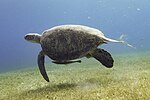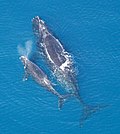ecology and nonlinear dynamics, consumer-resource models (CRMs) are a class of ecological models in which a community of consumer species compete for a common...
27 KB (4,412 words) - 04:28, 30 June 2024
Consumer–resource interactions are the core motif of ecological food chains or food webs, and are an umbrella term for a variety of more specialized types...
5 KB (602 words) - 06:40, 23 September 2024
A consumer in a food chain is a living creature that eats organisms from a different population. A consumer is a heterotroph and a producer is an autotroph...
5 KB (597 words) - 05:11, 17 November 2024
"Biomass transformation webs provide a unified approach to consumer-resource modelling". Ecology Letters. 14 (2): 113–24. Bibcode:2011EcolL..14..113G...
10 KB (980 words) - 18:23, 19 July 2024
Lotka–Volterra equations (redirect from Lotka-Volterra model)
equations for military forces Random generalized Lotka–Volterra model Consumer-resource model Cooke, D.; Hiorns, R. W.; et al. (1981). The Mathematical Theory...
33 KB (4,335 words) - 17:32, 2 October 2024
residue model, a model explaining electrospray ionization in mass spectrometry Cis-regulatory module, a region of DNA Consumer-resource model, a type...
3 KB (354 words) - 05:28, 6 November 2024
Trophic level (redirect from Tertiary consumer)
"consumers", and "reducers" (modified to "decomposers" by Lindeman). The three basic ways in which organisms get food are as producers, consumers, and...
26 KB (3,071 words) - 14:43, 30 October 2024
Herbivore (redirect from Primary consumer)
"Biomass transformation webs provide a unified approach to consumer-resource modelling". Ecology Letters. 14 (2): 113–124. Bibcode:2011EcolL..14..113G...
55 KB (6,372 words) - 02:09, 22 November 2024
available, but by the scarcest resource (limiting factor). The law has also been applied to biological populations and ecosystem models for factors such as sunlight...
12 KB (1,631 words) - 05:46, 25 April 2024
decomposers in existence. Models of trophic levels also often model energy transfer between trophic levels. Primary consumers get energy from the producer...
18 KB (2,034 words) - 19:25, 19 November 2024
v t e Ecology: Modelling ecosystems: Other components Population ecology Abundance Allee effect Consumer-resource model Depensation Ecological yield Effective...
9 KB (806 words) - 13:36, 19 October 2024
Ecological niche (redirect from Resource partitioning)
around "consumer-resource models" which largely split a given ecosystem into resources (e.g. sunlight or available water in soil) and consumers (e.g. any...
70 KB (8,412 words) - 22:50, 23 November 2024
is a proposition that two species which compete for the same limited resource cannot coexist at constant population values. When one species has even...
23 KB (2,731 words) - 02:17, 11 October 2024
v t e Ecology: Modelling ecosystems: Other components Population ecology Abundance Allee effect Consumer-resource model Depensation Ecological yield Effective...
6 KB (660 words) - 17:21, 22 October 2024
Marginal value theorem (section Modeling)
leaves the patch in order to maximize the ratio between resource intake and time. The consumer depletes the amount of resources in the patch where they...
13 KB (1,923 words) - 09:24, 2 February 2023
is a question of context and emphasis, rather than of definition. Consumer-resource systems Evolution (biology) Food chain Food energy Ingestion List...
28 KB (2,826 words) - 09:40, 6 September 2024
nutrition Consumer-resource systems Getz, Wayne M. (February 2011). "Biomass transformation webs provide a unified approach to consumer-resource modelling". Ecology...
21 KB (2,370 words) - 16:39, 16 July 2024
v t e Ecology: Modelling ecosystems: Other components Population ecology Abundance Allee effect Consumer-resource model Depensation Ecological yield Effective...
8 KB (819 words) - 09:07, 13 November 2024
v t e Ecology: Modelling ecosystems: Other components Population ecology Abundance Allee effect Consumer-resource model Depensation Ecological yield Effective...
7 KB (767 words) - 04:56, 14 November 2024
v t e Ecology: Modelling ecosystems: Other components Population ecology Abundance Allee effect Consumer-resource model Depensation Ecological yield Effective...
28 KB (3,006 words) - 15:23, 17 November 2024
v t e Ecology: Modelling ecosystems: Other components Population ecology Abundance Allee effect Consumer-resource model Depensation Ecological yield Effective...
9 KB (1,005 words) - 22:37, 1 November 2024
"Biomass transformation webs provide a unified approach to consumer-resource modelling". Ecology Letters. 14 (2): 113–24. Bibcode:2011EcolL..14..113G...
109 KB (11,580 words) - 20:03, 1 November 2024
387–398. ISBN 0-7923-6020-6 Biotechnology for Environmental Management and Resource Recovery. Springer. 2013. p. 179. ISBN 978-81-322-0876-1. "Chemolithotrophy...
12 KB (1,202 words) - 13:46, 26 June 2024
Mutualism (biology) (redirect from Service-resource relationship)
lagged behind those for predation, or predator-prey, consumer-resource, interactions. In models of mutualisms, the terms "type I" and "type II" functional...
44 KB (5,169 words) - 05:58, 18 November 2024
and their applications in environmental biotechnology for sustainable Resource recovery". Biotechnology Reports (Amsterdam, Netherlands). 28: e00563....
110 KB (11,776 words) - 19:26, 12 November 2024
Essay on the Principle of Population. Chapter I. A model of population growth bounded by resource limitations was developed by Pierre Francois Verhulst...
6 KB (736 words) - 13:24, 17 March 2024
Hillebrand H, et al. (July 2008). "A cross-system synthesis of consumer and nutrient resource control on producer biomass". Ecology Letters. 11 (7): 740–55...
31 KB (3,540 words) - 04:52, 14 September 2024
disturbance, succession, and the types of species present. While the resource inputs are generally controlled by external processes, the availability...
63 KB (6,950 words) - 22:30, 28 October 2024
W.; Collins, J.P. (1974). "Environmental certainty, trophic level, and resource availability in life history evolution". American Naturalist. 108 (964):...
30 KB (3,152 words) - 15:45, 9 September 2024
Soil food web (section Community matrix models)
web models, every link has two direct effects, one of the resource on the consumer and one of the consumer on the resource. The effect of the resource on...
27 KB (3,653 words) - 12:53, 6 June 2024



















